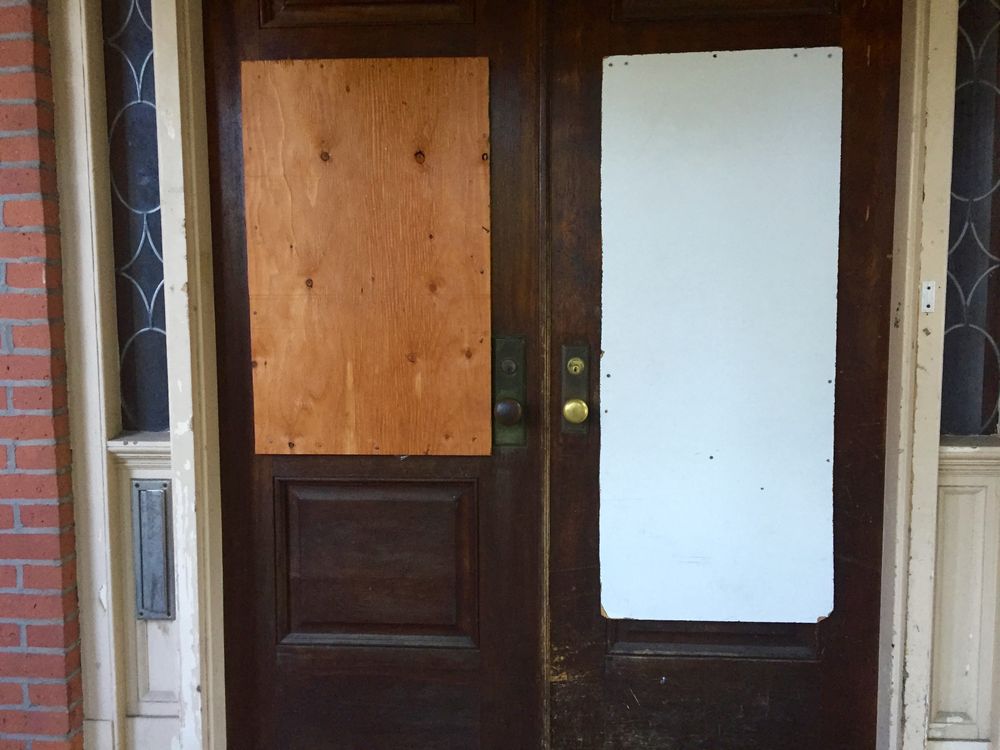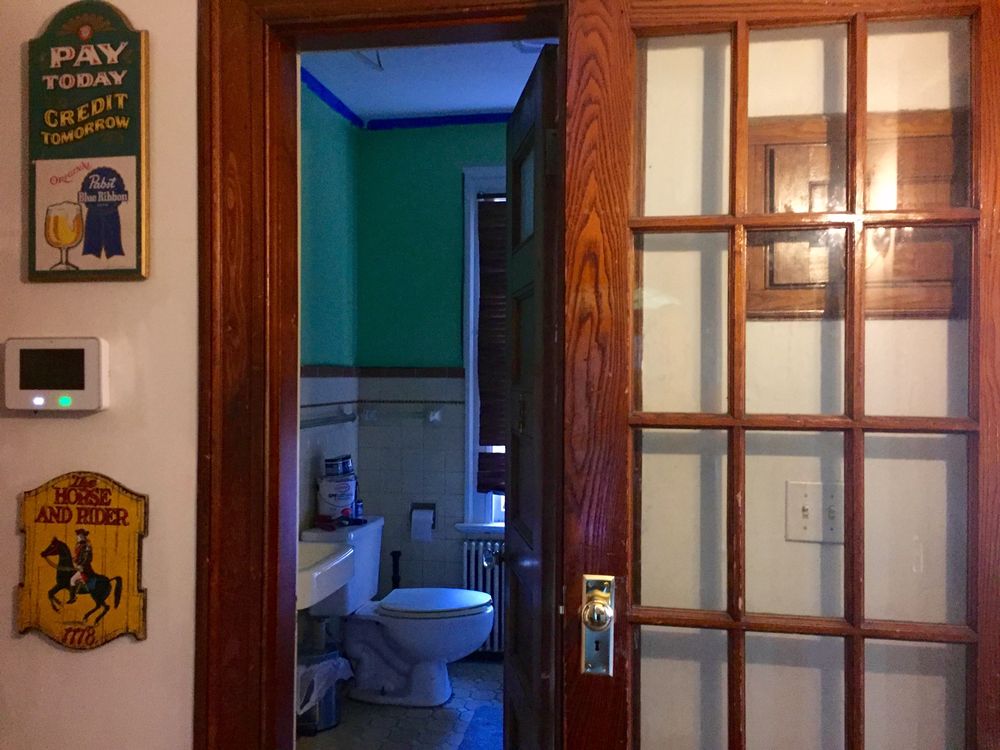
Fence House
15 High Street, New Haven, CT 06510
A holdout in the midst of a rapidly changing area, this red-brick house has been home to the Fence Club for some time now. Note the corinthian columns that support the front porch, brick quoins at the corners, a denticulated entablature and hipped roof.
High Street first appeared as a titled street in the city’s 1840 directory. It was, according to historian Edward Atwater, one of the first streets laid out in 1784 by New Haven’s settlers, and grew in length during the following years. It was named for its “high” position commercially, and may also have been named after Oxford University’s High Street. High street developed more slowly than its neighboring Chapel, Crown, and George streets, but experienced a great period of growth during the mid-19th century. At the turn of the twentieth century, apartment buildings and businesses were established on the street, and the block became increasingly commercialized. The first High Street apartments (the Oxford and Cambridge apartments) were built at the same time as the current Fence House in 1910. Since the early twentieth century, High Street has functioned as a mixed-use neighborhood with both residential and commercial properties. The street was renovated through urban renewal projects in the 1960s. Throughout its long history, the block has been home to an artificial flower manufacturer, restaurants, caterers, coffee shops, lawyers’ and doctors’ offices, barbers, and a funeral home.
Name, historic: Octagon House
15 High Street is now known among Yale students as the Fence House, and is home to seven members of the undergraduate organization / co-ed fraternity Fence Club. The home was constructed in 1910 and has a long residential and commercial history on High Street.
New Haven city directories track residents as far back as 1913, at which time James J. Lawton lived at 15 High Street. Lawton, born in 1849, was the manager of Fleischmann Co., a yeast manufacturer. According to the Connecticut Historical Commission Building Survey of 1982, the home’s earliest owner was Dr. Elmer W. Ferguson, circa 1913. Lawton’s mention as resident in the 1913 directory leads me to believe that either Lawton sold the property to Ferguson shortly after purchasing it, or Ferguson had been renting his property to Lawton in 1913. Ferguson, a chiropractor, lived in the home until the late 1970s. The property functioned as both his home and office—he saw patients in an office and examination room in the front left side of the house, a space now converted to bedrooms.
The city directory curiously omits a tenant’s name for the property in the 1980s, and was purchased by Salatto Real Estate in 1990. The real estate firm is named for two brothers, Joseph and James, who still own and manage many downtown properties. In 1999, the home was inhabited by Asha Richards, and from 2001-2006, by C. Yanicelli. The home was then dubbed the Theta House, functioning as a residential space for Yale students in the university’s Kappa Alpha Theta sorority. In 2010, Theta moved to a house on Crown Street, and Salatto began to fill 15 High Street’s 7 bedrooms with members of Yale’s Fence Club. The club houses weekly meetings in one of its first floor spaces, and weekly parties in the first and second floor common spaces. The home has a narrow backyard where events are also hosted, and a balcony where club members hang out. Though the location of the Fence House is, in many ways, optimal—close to other student housing, campus’ center, and High and Crown Street restaurants and bars—the home has been broken into a number of times in the past two years during attempted robberies.
15 High Street is now known among Yale students as the Fence House, and is home to seven members of the undergraduate organization / co-ed fraternity Fence Club. The home was constructed in 1910 and has a long residential and commercial history on High Street.
New Haven city directories track residents as far back as 1913, at which time James J. Lawton lived at 15 High Street. Lawton, born in 1849, was the manager of Fleischmann Co., a yeast manufacturer. According to the Connecticut Historical Commission Building Survey of 1982, the home’s earliest owner was Dr. Elmer W. Ferguson, circa 1913. Lawton’s mention as resident in the 1913 directory leads me to believe that either Lawton sold the property to Ferguson shortly after purchasing it, or Ferguson had been renting his property to Lawton in 1913. Ferguson, a chiropractor, lived in the home until the late 1970s. The property functioned as both his home and office—he saw patients in an office and examination room in the front left side of the house, a space now converted to bedrooms.
The city directory curiously omits a tenant’s name for the property in the 1980s, and was purchased by Salatto Real Estate in 1990. The real estate firm is named for two brothers, Joseph and James, who still own and manage many downtown properties. In 1999, the home was inhabited by Asha Richards, and from 2001-2006, by C. Yanicelli. The home was then dubbed the Theta House, functioning as a residential space for Yale students in the university’s Kappa Alpha Theta sorority. In 2010, Theta moved to a house on Crown Street, and Salatto began to fill 15 High Street’s 7 bedrooms with members of Yale’s Fence Club. The club houses weekly meetings in one of its first floor spaces, and weekly parties in the first and second floor common spaces. The home has a narrow backyard where events are also hosted, and a balcony where club members hang out. Though the location of the Fence House is, in many ways, optimal—close to other student housing, campus’ center, and High and Crown Street restaurants and bars—the home has been broken into a number of times in the past two years during attempted robberies.
Today, the block [High St.] boasts the Yale Center for British Art, three Yale fraternity houses, the Fence House, the Luther House, two other residential homes, and the Cambridge and Oxford Apartment buildings. The street is home mainly to Yale students who live off-campus. High Street is also dotted with commercial enterprises and eateries, including Olea, an upscale restaurant, Starbucks, Rubamba, and Soul de Cuba.
The Fence House sits on the corner of High and Crown streets, among many restaurants and bars. High Street feels less Yale-dominated as one moves down the block from Chapel to Crown streets. High Street functions as a social and residential space for Yale students, and according to historian Kirke D. Weaver, the block “survives today as temporary home for a transient student population, who are largely unaware of the history that has preceded them.” However, Crown Street is a nightlife and restaurant spot for New Haven residents as well, allowing for greater connection and exchange between students and city residents.
The Fence House sits on the corner of High and Crown streets, among many restaurants and bars. High Street feels less Yale-dominated as one moves down the block from Chapel to Crown streets. High Street functions as a social and residential space for Yale students, and according to historian Kirke D. Weaver, the block “survives today as temporary home for a transient student population, who are largely unaware of the history that has preceded them.” However, Crown Street is a nightlife and restaurant spot for New Haven residents as well, allowing for greater connection and exchange between students and city residents.
Both the architect and builder of the home are unknown. Fence House is a colonial revival home with much of its original infrastructure intact after a restoration in 1980. The home has 2.5 stories and a basement. The building signals its original grandeur with its moldings, balcony, large bay windows, and ionic column supports on the front porch. The home shows signs of both internal and external disrepair since it now functions as a residential and party space for students.
Connecticut Historical Commission Building Survey, 15 High Street, 1982. Print.
New Haven Directories, 1913-2006, New Haven Museum. Print.
New Haven Historic Resources Inventory: Phase I: Central New Haven, New Haven Museum Dana Archive, c. 1981. Print.
New Haven Real Estate Map, 1888, New Haven Museum, Dana Archive, page 5.
New Haven Real Estate Map, 1911, New Haven Museum, Dana Archive, page 9.
Nirenstein Realty Map Co., Business Section City of New Haven. Springfield, Mass. 1947. New Haven Museum.
Personal interviews with current and past members of Yale’s Fence Club and tenants of the Fence House: Raleigh Capozzalo ’17, James Lundeen ’11, Eric Nelson ’16, Pardha Ponugoti ’14. Personal interviews with current members of Yale Theta: Emma Hammurland ’16, Jessica Leao ’16. September 18-23, 2015.
Townshend, Doris B. The Streets of New Haven the Origin of their Names. New Haven, CT: New Haven Colony Historical Society, 1984. Print.
Vision Government Solutions. "15 High Street." 2014.Web..
Weaver, Kirke D. The History of 24-50 High Street. New Haven Museum. Print.
New Haven Directories, 1913-2006, New Haven Museum. Print.
New Haven Historic Resources Inventory: Phase I: Central New Haven, New Haven Museum Dana Archive, c. 1981. Print.
New Haven Real Estate Map, 1888, New Haven Museum, Dana Archive, page 5.
New Haven Real Estate Map, 1911, New Haven Museum, Dana Archive, page 9.
Nirenstein Realty Map Co., Business Section City of New Haven. Springfield, Mass. 1947. New Haven Museum.
Personal interviews with current and past members of Yale’s Fence Club and tenants of the Fence House: Raleigh Capozzalo ’17, James Lundeen ’11, Eric Nelson ’16, Pardha Ponugoti ’14. Personal interviews with current members of Yale Theta: Emma Hammurland ’16, Jessica Leao ’16. September 18-23, 2015.
Townshend, Doris B. The Streets of New Haven the Origin of their Names. New Haven, CT: New Haven Colony Historical Society, 1984. Print.
Vision Government Solutions. "15 High Street." 2014.Web.
Weaver, Kirke D. The History of 24-50 High Street. New Haven Museum. Print.
Researcher
Anna Meixler
Date Researched
Entry Created
June 4, 2017 at 8:47 AM EST
Last Updated
December 3, 2017 at 10:50 PM EST by null
Historic Name
Style
OtherCurrent Use
ResidentialEra
1910-1950Neighborhood
OtherTours
Touring Chapel, Crown & HighYear Built
c. 1910
Architect
Current Tenant
There are currently 7 Yale students, members of the undergraduate organization/co-ed fraternity Fence Club, who live in the house. Their bedrooms are on all of the 2.5 floors.
Roof Types
HipStructural Conditions
Good
Street Visibilities
Yes
Threats
External Conditions
Good
Dimensions
Street Visibilities
Yes
Owner
Ownernishp Type
Client
James J. Lawton, manager of Fleischmann Co.
Historic Uses
Residential
(photo: Anna Meixler 9/13/15)

(photo: Anna Meixler 9/13/15)

(photo: Anna Meixler 9/13/15)
Comments
You are not logged in! Please log in to comment.